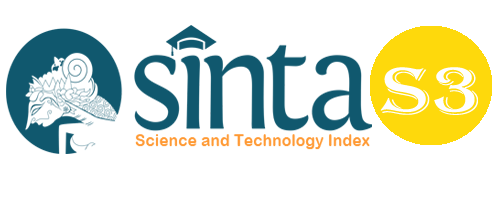Bottle Neck Point Rattan Industry Cluster Development in Palu City
Abstract
Rattan industry has been designated as a core competency of regional industry (KIID) Palu City, which will be encouraged to become a commodity and product as a regional superior because of the availability of abundant rattan resources. Although Central Sulawesi Province is the largest supplier of rattan in Indonesia, rattan industry clusters actually grow and develop in various places outside Central Sulawesi. The purpose of this research is specifically to identify bottleneck points for the development of the Palu City rattan industry, because the development efforts of the Palu City rattan industry have not been optimal until now. The bottleneck point reflects the main problem that must be immediately resolved. The research paradigm is qualitative, with phenomenological analysis tools. For this reason, the researcher is the main instrument in this study. The number of key informants consisted of 9 key informants consisting of 4 business people, namely 2 rattan furniture and 2 rattan accessories, 3 government elements and 2 academics involved in rattan research. The results of this study indicate that the bottleneck point occurs in the sociohistorical aspects of product, industrialization, and sustainability in the development of the rattan industrial cluster in Palu City.
Keywords
Full Text:
PDFReferences
Agustina, T. S. (2011). Peran Inkubator Bisnis Perguruan Tinggi Dalam Meminimalkan Resiko Kegagalan Bagi Wirausaha Baru Pada Tahap Awal (Start-Up). Majalah Ekonomi, 1, 64–74. http://journal.lib.unair.ac.id/index.php/ME/article/view/834/829
Asngadi, & Mas’adah. (2018). Industrialization of Small Medium Enterprises. 231(Amca), 186–189. https://doi.org/10.2991/amca-18.2018.51
Astuti, D. S., & Lutfi, M. (2020). Analisis Pengaruh Kualitas Pelayanan Dan Kepuasan Pelanggan Terhadap Loyalitas Pelanggan. In Jurnal Ekobis : Ekonomi Bisnis & Manajemen (Vol. 9, Issue 2). https://doi.org/10.37932/j.e.v9i2.64
Basukianto, Supriyanto, A., & Rozak, J. A. (2017). Model informasi klaster umkm dan potensi wilayah berbasis peta web sebagai dasar pengembangan ekonomi daerah 1. Prosiding Seminar Nasional Multi Disiplin Ilmu.
Chaminade, C., & Vang, J. (2008). Globalisation of knowledge production and regional innovation policy: Supporting specialized hubs in the Bangalore software industry. Research Policy, 37(10), 1684–1696. https://doi.org/10.1016/j.respol.2008.08.014
Chang, F. Y. M., & Webster, C. M. (2019). Influence of Innovativeness, Environmental Competitiveness and Government, Industry and Professional Networks on SME Export Likelihood. Journal of Small Business Management. https://doi.org/10.1111/jsbm.12446
Cunningham, S., & Higgs, P. (2009). Measuring creative employment: Implications for innovation policy. Innovation: Management, Policy and Practice, 11(2), 190–200. https://doi.org/10.5172/impp.11.2.190
Darmasetiawan, N. K., Idrus, M. S., Troena, E. A., & Salim, U. (2013). Application Concept of Social Capital Theory and Social Exchange Theory on Organizational Trust , Willingness To Share , Membership Involvement , and Knowledge Obtaining Dimensions in Industry Cluster. International Journal of Business and Behavioral Sciences, 3(2), 15–33.
DEMİRCİ, A. E., & ÖZDEMİR, A. A. (2012). Impact of Social Capital on Radical Innovation Efforts of the Organizations: A Case in the Aviation Industry. Ege Akademik Bakis (Ege Academic Review), 12(1), 53–53. https://doi.org/10.21121/eab.2012119546
Dewi, N., Miharja, M., & Yudoko, G. (2015). Analisis Kebijakan Distribusi Bahan Baku Rotan Dengan Pendekatan Dinamik Sistem Studi Kasus Rotan Indonesia. Jurnal Perencanaan Wilayah Dan Kota. https://doi.org/10.5614/jpwk.2015.26.3.3
Eskak, E. (2016). Krisis Bahan Baku Seni Kerajinan Kayu di Jepara dan solusi Pemecahannya. Dinamika Kerajinan Dan Batik: Majalah Ilmiah.
Hermanto, N. (2018). Pengentasan Kemiskinan di Perdesaan: Pengembangan SDM, Penguatan Usaha, dan Inovasi Pertanian. Forum Penelitian Agro Ekonomi. https://doi.org/10.21082/fae.v35n2.2017.139-150
Hongqiang, Y., Chunyi, J., Ying, N., & Yinxing, H. (2012). China’s wood furniture manufacturing industry: Industrial cluster and export competitiveness. Forest Products Journal, 62(3), 214–221. https://doi.org/10.13073/0015-7473-62.3.214
Husnah. (2013). Aset tak wujud, strategi bersaing dan kinerja keuangan: Universitas Brawijaya.
Irawati, D. (2006). Understanding The Triple Helix Model from The Perspective of the Developing Country: A Demand or A Challenge for Indonesian Case Study? MPRA-Munich Personal RePEc Archive, 5829, 16. http://mpra.ub.uni-muenchen.de/5829/
Kalnins, A., & Chung, W. (2006). Social capital, geography, and survival: Gujarati immigrant entrepreneurs in the U.S. lodging industry. Management Science, 52(2), 233–237. https://doi.org/10.1287/mnsc.1050.0481
Kota Palu. (2015). Kota Palu dalam Angka.
Kusnaedi, I., & Pramudita, A. S. (2013). Sistem Bending pada Proses Pengolahan Kursi Rotan Cirebon. Jurnal Rekajiva, 1(2), 1–13.
Kutnjak, G., Miljenović, D., & Mirković, A. (2019). Improving competitiveness of small and medium-sized enterprises with the application of quality management systems. Pomorstvo. https://doi.org/10.31217/p.33.1.2
Lee, S. C., Barker, S., & Kandampully, J. (2003). Technology, service quality, and customer loyalty in hotels: Australian managerial perspectives. Managing Service Quality: An International Journal. https://doi.org/10.1108/09604520310495886
Leonidou, L. C., Palihawadana, D., & Theodosiou, M. (2011). National Export-Promotion Programs as Drivers of Organizational Resources and Capabilities : Effects on Strategy ,. 19(2), 1–29.
Mahyarni. (2012). Faktor-faktor yang mempengaruhi keinginan dan perilaku berbagi pengetahuan. Universitas Brawijaya.
Mate, B. F. J., Fuerst, W. L., & Barney, J. B. (1995). Information Technology and Sustained Competitive Advantage : A Analysis IT and Competitive Advantage : Previous Literature. December, 487–506.
Muis, I., Solikin, S., & Riana, D. (2019). Strategic Marketing and Digital Marketing Training Activities for the Rattan Processing Industries in Cirebon Regency [Pelatihan Pemasaran Strategik dan Digital untuk Industri Pengolah Rotan di Kabupaten Cirebon]. Proceeding of Community Development. https://doi.org/10.30874/comdev.2018.400
Muizu, W. O. Z., & Effendi, N. (2015). Penguatan Sdm Industri Kreatif Melalui Peningkatan Kompetensi Dan Knowledge Management. PEKBIS ( Jurnal Pendidikan Ekonomi Dan Bisnis ).
Müller, J. M., Buliga, O., & Voigt, K. I. (2020). The role of absorptive capacity and innovation strategy in the design of industry 4.0 business Models-A comparison between SMEs and large enterprises. European Management Journal. https://doi.org/10.1016/j.emj.2020.01.002
Nangoy, O. M. (2011). Terpuruknya Industri Mebel Rotan Cirebon. Humaniora. https://doi.org/10.21512/humaniora.v2i1.2940
Panggabean, R. (2010). Kajian pengembangan UMKM di sentra klaster rotan Kabupaten Cirebon. Jurnal Pengkajian Koperasi Dan UKM.
Perry, M., & Tambunan, T. T. H. (2009). Re-visiting Indonesian cases for cluster realism. Journal of Enterprising Communities, 3(3), 269–290. https://doi.org/10.1108/17506200910982028
Porter, M. E. (2008). The five competitive forces that shape strategy. Harvard Business Review.
Raharjana, D. T., & Putra, H. S. A. (2020). Penguatan SDM dalam e-Marketing untuk Promosi Desa Wisata di Kabupaten Malang. Jurnal Nasional Pariwisata. https://doi.org/10.22146/jnp.60403
Reddy, Y. V., & Naik, S. S. (2011). Determinants of goan SME firms going global: Theoretical and empirical approach. Vikalpa, 36(2), 45–58. https://doi.org/10.1177/0256090920110204
Rosenfeld, S. A. (2002). Creating Smart Systems A guide to cluster strategies in less favored regions. April.
Sabatini, F. (2005). Does Social Capital Improve Labour Productivity in Small and Medium Enterprises ? August, 1–28.
Shah, M. et al. (2020). The Development Impact of PT. Medco E & P Malaka on Economic Aspects in East Aceh Regency. Budapest International Research and Critics Institute-Journal (BIRCI-Journal). P. 276-286.
Singh, R. K., Garg, S. K., & Deshmukh, S. G. (2008). Strategy development by SMEs for competitiveness: A review. In Benchmarking: An International Journal. https://doi.org/10.1108/14635770810903132
Smith, A. (2003). Power relations, industrial clusters, and regional transformations: Pan-European integration and outward processing in the Slovak clothing industry. Economic Geography. https://doi.org/10.1111/j.1944-8287.2003.tb00200.x
Sriwarno, A. B., & Djati, I. D. (2009). Enhancing Local Designers Skill in Rattan Furniture Industries in Cirebon through Comprehensive-Design Approach Regarding Buyers’ Dependencies Prevention. ITB Journal of Visual Art and Design. https://doi.org/10.5614/itbj.vad.2009.3.2.7
Sulteng Post, 2014, Menteri Perindustrian Resmikan Pirnas Palu, Sulteng Post, 8 Desember 2014. Diakses 14 Januari 2021.
Supeni, E. (2019). Penerapan Model Triple Helix Dan Keunggulan Bersaing Pada Ukm Industri Kreatif Di Kabupaten Sidoarjo. Prosiding Konferensi Nasional Pengabdian Kepada Masyarakat Dan Corporate Social Responsibility (PKM-CSR). https://doi.org/10.37695/pkmcsr.v2i0.444
Taçoğlu, C., Ceylan, C., & Kazançoğlu, Y. (2019). Analysis of variables affecting competitiveness of smes in the textile industry. Journal of Business Economics and Management. https://doi.org/10.3846/jbem.2019.9853
Turyakira, P., Venter, E., & Smith, E. (2014). THE IMPACT OF CORPORATE SOCIAL RESPONSIBILITY FACTORS ON THE COMPETITIVENESS OF SMALL AND MEDIUM - SIZED ENTERPRISES Introduction and CSR factors that influence the competitiveness of SMEs The primary objective of this research is to. 17(1), 157–172.
Yokakul, N., & Zawdie, G. (2009). The role of triple helix for promoting social capital, industrial technology and innovation in the SME sector in Thailand. Science, Technology and Society, 14(1), 93–117. https://doi.org/10.1177/097172180801400104
Zulfikar, T. (2014). Pengaruh CAR, LDR, NPL, BOPO dan NIM Terhadap Kinerja Profitabilitas (ROA) Bank Perkreditan Rakyat Di Indonesia. In E-Journal Graduate Unpar.
DOI: https://doi.org/10.33258/birci.v5i2.5784
Article Metrics
Abstract view : 52 timesPDF - 18 times
Refbacks
- There are currently no refbacks.

This work is licensed under a Creative Commons Attribution-ShareAlike 4.0 International License.

This work is licensed under a Creative Commons Attribution-ShareAlike 4.0 International License.

_.gif)

















_.gif)



